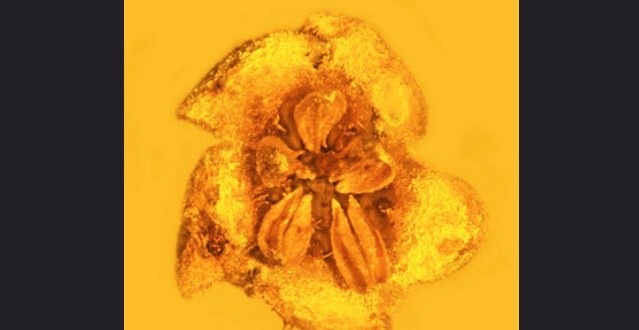Researchers have discovered two flower specimens entombed in ancient sap that belong to a genus notorious for producing the deadly toxin strychnine.
But these two 20-30 million-year-old fossil flowers, found perfectly preserved in a piece of amber, came from the dark side of the asterid family – they belong to the genus Strychnos, which ultimately gave rise to some of the world’s most famous poisons, including strychnine and curare.
Poisons that would later find their way into blow-gun weapons, rat control, Sherlock Holmes stories and the movie “Psycho” appear to have had some of their ancestral and biological roots in the prehistoric jungles of what’s now the Dominican Republic, researchers say.
“The specimens are beautiful, perfectly preserved fossil flowers, which at one point in time were borne by plants that lived in a steamy tropical forest with both large and small trees, climbing vines, palms, grasses and other vegetation,” said George Poinar, Jr., a courtesy professor in the College of Science at Oregon State University, and one of the world’s experts on plant and animal life forms preserved in amber.
“Specimens such as this are what give us insights into the ecology of ecosystems in the distant past,” Poinar said. “It shows that the asterids, which later gave humans all types of foods and other products, were already evolving many millions of years ago.”
Asterids, the researchers noted in this study, are among Earth’s most important and diverse plants, with 10 orders, 98 families, and about 80,000 species. They represent about one-third of all the Earth’s diversity of angiosperms, or flowering plants.
And one ancient genus, which has now been shown to be inherently toxic, existed for millions of years before humans appeared on the planet.
“Species of the genus Strychnos are almost all toxic in some way,” Poinar said. “Each plant has its own alkaloids with varying effects. Some are more toxic than others, and it may be that they were successful because their poisons offered some defense against herbivores.
“Today some of these toxins have been shown to possess useful and even medicinal properties.”
As natural poisons that humans came to understand and use, two extracts from plants in the Strychnos genus ultimately became famous – strychnine and curare.
Strychnine had practical uses for decades as a pesticide, and was often the deadly component of rat poison. But it also captured the imagination of writers, and was used by Norman Bates in the movie “Psycho” to kill his mother and her male companion. In small doses, it can increase mental and muscular activity.
Curare has an even stranger history. Sir Walter Raleigh may have first encountered it in 1596 when he observed poison arrows in South America, where natives also developed the poison in blow-gun darts to paralyze hunted prey. Curare was featured as the murder weapon in one Sherlock Holmes novel, and in lower doses it has been used as a muscle relaxant in surgery.
There are now about 200 species of Strychnos plants around the world, in forms ranging from shrubs to trees and woody climbing vines, mostly in the tropics. They are still being studied for medicinal properties, such as for the treatment of parasitic worm infections and even as drugs to treat malaria.
The discovery of these two fossil flowers, researchers said, suggests that many other related plant families could have evolved in the Late Cretaceous in tropical forests. Their fossil remains, however, still await discovery.
Agencies/Canadajournal
 Canada Journal – News of the World Articles and videos to bring you the biggest Canadian news stories from across the country every day
Canada Journal – News of the World Articles and videos to bring you the biggest Canadian news stories from across the country every day



